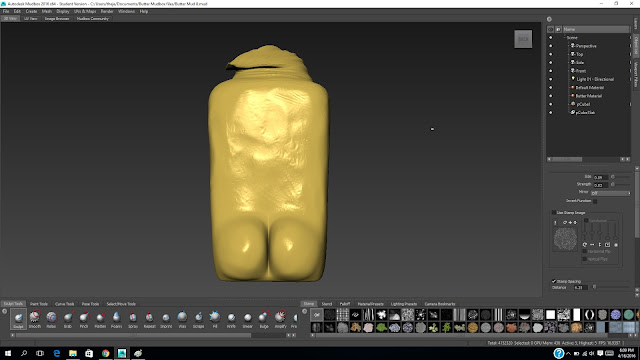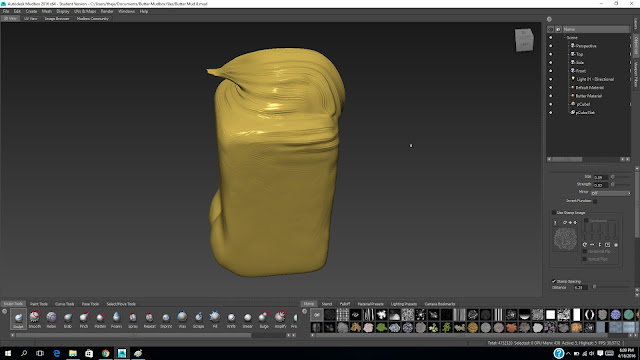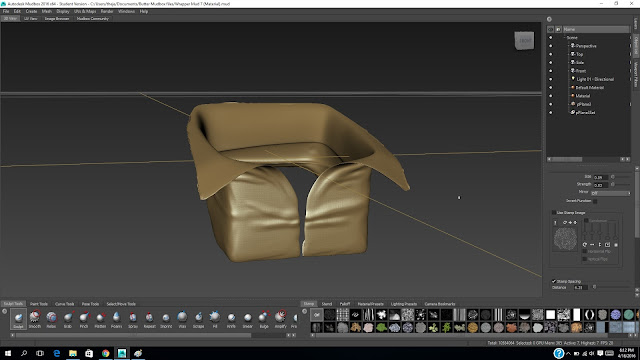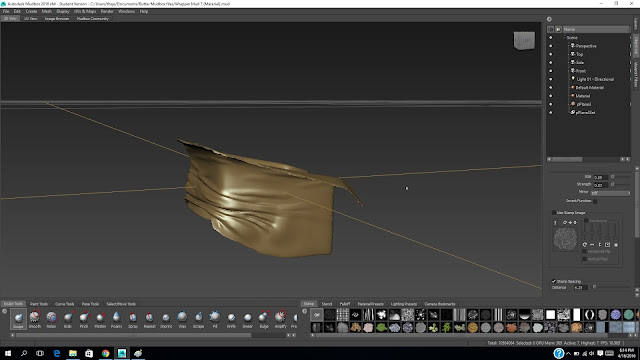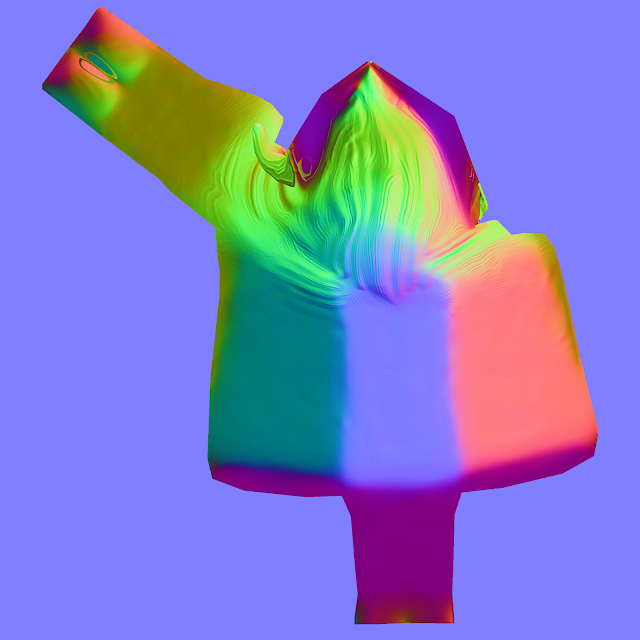Tuesday 19 April 2016
Mudbox
I modelled the textures of the butter and the wrapper in mudbox. The normal maps for the wrapper and the butter are also included.
Wednesday 13 April 2016
Wrapper
I've finished modelling the wrapper. I made the UV even so that the wrinkles would deform the texts.






I'll do the wrinkles and textures in mudbox. Jonathan has the PSD file for the butter wrapper. I'll use that for the diff elements in the wrapper such as the logo and the bar code.
This is a print of the UV map.






I'll do the wrinkles and textures in mudbox. Jonathan has the PSD file for the butter wrapper. I'll use that for the diff elements in the wrapper such as the logo and the bar code.
This is a print of the UV map.
Thursday 7 April 2016
Interactive Narrative Week 7 Blog Entry 6
For this week I played the game Amnesia: The Dark Descent. It is pointed out in the opening of the game that it was made for exploring the game world. And for me, I think that the most interesting narrative element in the game is the player's role in progressing the story. The protagonist, Daniel, acts as the player's avatar in the game; the embodiment of presence and agency within that world. There is a good relationship between the duality of the character and the player. The case of amnesia that Daniel is suffering provides a perfect situation to integrate the personalities of the character and the player.
Daniel is the main character of the game. He is also a character in a sense that he is imbued with certain characteristics; he has his own identity separate from the player. The state of amnesia provides a great vehicle for the player to imbue the avatar with his/her own personality. The identity of the character (Daniel) only comes in certain situations, mostly through diary entries and notes (and a flashback gameplay). As the game progresses, the identity of Daniel slowly forms.
The game has a linear narrative. The gameplay is non-linear as the player has to explore different sections of the castle to gather items that are essential in progressing the story. Daniel has to collect tinder cans and oil for the torch to keep him sane. Not only is it a mechanic of the game but player empathy plays a part in this. The player empathizes with the character he/she is controlling. As Daniel is an avatar of the player, the player is driven to keep his/her avatar as healthy as they can in order to progress the story.
According to Salen and Zimmerman, players are constantly shifting between cognitive frames that alternately place them “inside” their character in a relationship of direct identification and very much outside of it, aware of the character as an artificial construct and fictional entity, as well as their own status as players manipulating a tool or “puppet” according to the rules of the game. - Jessica Aldred, Characters (2013)
Double consciousness exists within the avatar of the game, When Daniel moves about the game world and interacting with different objects, the player's consciousness is the one present. But when the diary entries are narrated, the consciousness of Daniel comes into play and that reminds the player that he/she is playing as that character. The game uses diary entries and notes as exposition for the character to give Daniel context; how he fits in with the game world. The game is about exploring and that ties into the story itself which is a mystery that has to be uncovered by navigating different areas for certain items to progress it. Information about the story is told directly to the character, which is the player's avatar in the game world, through interaction with different objects.
The player's role is important in the progression of the story because without the player, the avatar is essentially non-existent; an empty husk. In saying that, the avatar is also important for the player because it embodies the player's presence and agency. The avatar is both ludic and representational because it is a stand in for the player. It has a certain mechanism which evokes empathy from the player eg. sanity level and health. It is representational because it is an entity that exists within the fictional world. The story makes sense through this fictional entity (Daniel) in the game.
References:
Aldred J. (Author). (2013). ,Characters from: The Routledge Companion to Video Game Studies [Book]. Retrieved from: http://animation.onlearn.co.nz/pluginfile.php/2711/mod_resource/content/0/Characters.pdf
Daniel is the main character of the game. He is also a character in a sense that he is imbued with certain characteristics; he has his own identity separate from the player. The state of amnesia provides a great vehicle for the player to imbue the avatar with his/her own personality. The identity of the character (Daniel) only comes in certain situations, mostly through diary entries and notes (and a flashback gameplay). As the game progresses, the identity of Daniel slowly forms.
The game has a linear narrative. The gameplay is non-linear as the player has to explore different sections of the castle to gather items that are essential in progressing the story. Daniel has to collect tinder cans and oil for the torch to keep him sane. Not only is it a mechanic of the game but player empathy plays a part in this. The player empathizes with the character he/she is controlling. As Daniel is an avatar of the player, the player is driven to keep his/her avatar as healthy as they can in order to progress the story.
According to Salen and Zimmerman, players are constantly shifting between cognitive frames that alternately place them “inside” their character in a relationship of direct identification and very much outside of it, aware of the character as an artificial construct and fictional entity, as well as their own status as players manipulating a tool or “puppet” according to the rules of the game. - Jessica Aldred, Characters (2013)
Double consciousness exists within the avatar of the game, When Daniel moves about the game world and interacting with different objects, the player's consciousness is the one present. But when the diary entries are narrated, the consciousness of Daniel comes into play and that reminds the player that he/she is playing as that character. The game uses diary entries and notes as exposition for the character to give Daniel context; how he fits in with the game world. The game is about exploring and that ties into the story itself which is a mystery that has to be uncovered by navigating different areas for certain items to progress it. Information about the story is told directly to the character, which is the player's avatar in the game world, through interaction with different objects.
The player's role is important in the progression of the story because without the player, the avatar is essentially non-existent; an empty husk. In saying that, the avatar is also important for the player because it embodies the player's presence and agency. The avatar is both ludic and representational because it is a stand in for the player. It has a certain mechanism which evokes empathy from the player eg. sanity level and health. It is representational because it is an entity that exists within the fictional world. The story makes sense through this fictional entity (Daniel) in the game.
References:
Aldred J. (Author). (2013). ,Characters from: The Routledge Companion to Video Game Studies [Book]. Retrieved from: http://animation.onlearn.co.nz/pluginfile.php/2711/mod_resource/content/0/Characters.pdf
Frictional Games (Developer). (2010). Amnesia: The Dark Descent [Video Game]. Sweden: Frictional Games
Friday 1 April 2016
Interactive Narrative Week 6 Blog Entry 5
For this week I played Grim Fandango. As the player of the game, I control a character named Manuel "Manny" Calavera as I interact with other characters which are non-playable. I wouldn't consider Manny as an avatar based on Laetitia Wilson's definitions of character and avatar. Laetitia Wilson (2003) suggests that avatars are virtual selves that stand in
for our real-space selves, at the same time as they function “as a locus for our extended
agency; a locus that is multifarious and polymorphous, displaced from the reality of our
realspace selves.” Wilson asserts that video
game characters are interpassive entities rather than truly “interactive” ones, soliciting
“a mode of relating that involves the consensual transferral of activity or emotion onto
another being or object—who consequently ‘acts’ in one’s place” - Jessica Aldred, Characters (2013).
Manny is already a premade persona imbued with certain personality and traits. In the game, I can't alter these traits but just merely physically control him. Even with his conversations with other characters of the game, I can only choose what he would say. He says his lines as the character he is. He is a character with an identity for himself; an icon for the game franchise he is in.
The game has a linear narrative. My involvement is what allows the story to progress and the character to develop. I direct the interpassive character to objects or people to interact with. The character is interpassive because I act in its place. Interaction only occurs when the character interacts with other characters, wherein I receive information (story and task info) from the game as it receives information from me to go talk to a certain character. Grim Fandango is an ergodic literary work, almost like a movie rather than a game. Ergodic literature is literature that is not needed to be read; in this case (video game) it can be experienced. Grim Fandango is a cybertext, like a hypertext fiction but without the trivial effort, wherein each object and NPC provide information for the story and what is needed in order to progress. Espen J. Aarseth states that non trivial effort is needed in order to traverse the text in ergodic literature (Cybertext- Perspectives of Ergodic Literature, 1997). There is no clear sequence for the story to be uncovered in the game and that's the reason why the traversal of the player, through the iconic character, into the game is needed. Non-trivial effort (point and click to control the character) is required for the character to follow the path needed to be taken in order to progress the story. The story can be experienced by controlling an interpassive character as the player physically moves this character within the game world to interact with NPCs.
References:
Aldred J. (Author). (2013). Characters from: The Routledge Companion to Video Game Studies [Book]. Retrieved from: http://animation.onlearn.co.nz/pluginfile.php/2711/mod_resource/content/0/Characters.pdf
LucasArts (Developer). (1998). Grim Fandango [Video Game]. United Sates: LucasArts
Wilson, L. (Author). (2003). Interactivity or Interpassivity: a Question of Agency in Digital Play [Article]. Australia: University of Australia
Aarseth, E. (Author). (1997). Cybertext- Perspectives of Ergodic Literature [Article]. United States: John Hopkins University Press
Manny is already a premade persona imbued with certain personality and traits. In the game, I can't alter these traits but just merely physically control him. Even with his conversations with other characters of the game, I can only choose what he would say. He says his lines as the character he is. He is a character with an identity for himself; an icon for the game franchise he is in.
The game has a linear narrative. My involvement is what allows the story to progress and the character to develop. I direct the interpassive character to objects or people to interact with. The character is interpassive because I act in its place. Interaction only occurs when the character interacts with other characters, wherein I receive information (story and task info) from the game as it receives information from me to go talk to a certain character. Grim Fandango is an ergodic literary work, almost like a movie rather than a game. Ergodic literature is literature that is not needed to be read; in this case (video game) it can be experienced. Grim Fandango is a cybertext, like a hypertext fiction but without the trivial effort, wherein each object and NPC provide information for the story and what is needed in order to progress. Espen J. Aarseth states that non trivial effort is needed in order to traverse the text in ergodic literature (Cybertext- Perspectives of Ergodic Literature, 1997). There is no clear sequence for the story to be uncovered in the game and that's the reason why the traversal of the player, through the iconic character, into the game is needed. Non-trivial effort (point and click to control the character) is required for the character to follow the path needed to be taken in order to progress the story. The story can be experienced by controlling an interpassive character as the player physically moves this character within the game world to interact with NPCs.
References:
Aldred J. (Author). (2013). Characters from: The Routledge Companion to Video Game Studies [Book]. Retrieved from: http://animation.onlearn.co.nz/pluginfile.php/2711/mod_resource/content/0/Characters.pdf
LucasArts (Developer). (1998). Grim Fandango [Video Game]. United Sates: LucasArts
Wilson, L. (Author). (2003). Interactivity or Interpassivity: a Question of Agency in Digital Play [Article]. Australia: University of Australia
Aarseth, E. (Author). (1997). Cybertext- Perspectives of Ergodic Literature [Article]. United States: John Hopkins University Press
Subscribe to:
Posts (Atom)

